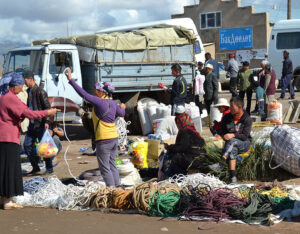Into EurAsia – Monitoring the EU’s Central Asia Strategy: executive summary and recommendations

The EU’s Central Asia strategy was introduced in 2007 in order to upgrade the EU’s cooperation with the five states of the region. The political context at that time was dominated by concerns in the EU over energy security and the war in Afghanistan. The strategy took a wide and comprehensive approach however, identifying a considerable number of priority actions (political dialogue, human rights and the rule of law, education, economic development, energy and transport links, environmental sustainability and water, common threats such as drug trafficking, etc).
This approach has led to engagement in many dialogue procedures and projects. While there has been an undoubted increase in the level of activity, the extensiveness of the agenda and relatively low level of resources committed to the strategy entails a risk that the whole process may not have real impact and credibility. This risk is quite visible in most chapters of the strategy. For the time being it is felt by EU officials that these are early days still, and that results take time, and there has to be patience to deepen trust and experience in the region. Up to a point this may be valid. Yet there is a manifest need to sharpen the real operational objectives and raise the level of operations to the point of being demonstrably effective.
Our shortlist of critical recommendations in this sense is divided into two categories – the strategic and general, and then the more specific and technical:
Strategic aspects:
1. Well into its third year of implementation, the EU would do well to engage in a critical review of the Strategy. The political process could be initiated by the current Spanish EU Council Presidency in the first half of 2010 together with the new High Representative for foreign and security policy. A possible re-vamping of the strategy would be more appropriate in 2011 when the new External Action Service is in place.
2. The EU has some clear security concerns in relation to Central Asia: energy supply security through diversification of sources, and linkages with Afghanistan (supply logistics, political spillover risks, drug trafficking). All these security issues are quite rightly enumerated in the EU strategy and sit alongside the EU’s general branding of its foreign policy strategy as seeking to contribute to the development of a normative, rule-based world order with strong reliance on human rights, international law, regional cooperation and multilateral institutions. Contrary to certain debates, we do not see this as a conflict of interests versus values, as long as legitimate interests are pursued in a principled manner. However, Central Asia presents a real challenge in this regard, since the present state of governance in the region is so distant from these principles. This presents the EU with a choice: either to pass over its preferred principles in this case, or to make a special effort to apply its principled approach in ways that are realistically operational in this difficult political environment. The EU strategy struggles to pursue the second approach, but not without ambiguity. This report seeks to clarify and reinforce such an approach. To do this effectively is crucial for the credibility of the EU’s chosen role as a global actor working to promote a normative world order. A fuller discussion of the issues of principle is included at the end of this report.
3. The case of Kazakhstan deserves special mention as a key country in the region that has chosen to reply to the EU strategy by adopting its own ‘Path to Europe’. Coupled with Kazakhstan’s new chairmanship in 2010 of the OSCE, this European orientation as part of a multi-vectored foreign policy presents an important opportunity for political and economic convergence with Europe, including deepening relations with the Council of Europe. These strategic directions have been announced, and the EU has also responded by agreeing to work towards a new treaty-level agreement with Kazakhstan. These developments are to be welcomed, but should be accompanied by clarity over the steps in the political sphere that Kazakhstan needs to make, progressively, for this to be a real movement beyond mere political declarations. If this succeeds it should have a wider demonstration effect elsewhere in Central Asia, which would be an achievement of strategic importance. In particular it is to be hoped that a positive momentum in EU relations with Uzbekistan becomes feasible.
4. The EU’s concept of regional cooperation in Central Asia needs revision. Intra-regional cooperation is surely desirable and the EU rightly tries to facilitate this. However it should not be over-emphasised in relation to opportunities for regional cooperation with neighbours external to the region (Eastern Europe, Russia, China and South Asia), and where the EU has several major interests (e.g. in energy, transport and security). The EU does work on this wider regionalism with projects to link Central Asia to its Eastern Partnership initiative, but with limited regard to the region’s Asian neighbours so far. Such elements of wider regional cooperation could help disenclave the land-locked Central Asia, and for the EU contribute to a wider ‘EurAsia strategy’ overarching and going beyond the several regional dimensions of the EU’s present neighbourhood policy. This wider EurAsian dimension, involving all the major powers of the EurAsian landmass, would fit in with the increasingly evident need to channel the new global multi-polar dynamics into an ordered world system. These considerations go well beyond concern for Central Asia alone, but the region is inevitably going to be at the cross-roads of many issues of global significance.
Specific aspects:
5. The EU intends to increase its diplomatic presence in the region, and with the impetus of the new Lisbon Treaty provisions this needs to be done decisively, with adequately staffed EU delegations in all five states. It is already a positive feature of the Central Asia strategy that ways are being developed for individual member states of the EU to work more actively and synergetically with the Commission in the execution of various projects; to do this might seem obviously desirable, but it has not often been seen in practice so far.
6. In the human rights field a structured process has been set up at both official and civil society levels. But this needs to be carefully upgraded, without which it risks becoming little more than a token routine of political convenience for both sides. Requests to make the process symmetrical, with dialogue on EU experience in managing difficult human rights issues, should receive a positive response. The interaction between the official dialogues and civil society seminars could be strengthened, with the civil society seminars invited to undertake regular year-to-year monitoring of progress in relations to appropriate benchmarks. Publication of the results and recommendations of civil society seminars is in principle being done, but these are not yet accessible on Commission websites.
7. Concerning the rule of law initiative, it is too early to judge results since such work needs to be sustained over a longterm period. We call for the formulation of clear and practical benchmarks to evaluate progress in this field in a public document setting out the EU’s priorities and strategies. The full development of this initiative is important as a values-driven commitment to the region, especially given the absence of an explicit democratisation agenda.
8. The sanctions on Uzbekistan after the Andjian events in 2005 did not yield substantial change and have now been lifted for the sake of engaging with the regime. If the EU should in future resort to such measures in Central Asia (or elsewhere) it has to be disciplined and unified. Naturally this is a topic that elicits a range of political positions in democracies such as the EU, but when the decision is made it has to be loyally backed by all, otherwise the operation and the EU itself is discredited.
9. The Education Initiative so far mainly repackages existing programmes, but with a significant increase in funding, with both Tempus and Erasmus Mundus now to receive doubled funding from €5 to €10 million annually, the launch of a policy dialogue, and with the Bologna process serving to frame the reform of educational structures (notably in Kazakhstan and Kyrgyzstan). This increased prioritisation of education within the total aid effort is to be welcomed. However, the Commission should now evaluate the first results of the Erasmus Mundus programme in the region, which seems not be adequately adapted to Central Asian realities, and undertake a broader education strategy review for Central Asia. Consideration should be given to other projects (examples are given below) with a view to a clearer branding of the EU as promoter of a cluster of high-quality and independent education and research institutions, as well as a supporter of reform of the basic education systems. There are also some changes in the management of the Education Initiative within the Commission that seem to be warranted.
10. In the area of water management and hydro-electric power there is a robust case for major investment in upstream states that could also bring huge benefits for downstream states, and avert the real risks of inter-state conflict over water. These risks are now heightened with the disintegration of the regional electricity grid. The EU is engaging in multiple initiatives in the area, ranging from the technical to political dialogue. This dialogue seems to remain rather general and superficial, however. While the EU is not in a position to lead on a resolution of the key water problem, it could help establish the technical-economic case for investment in increased hydroelectric capacity that could offer benefits to both upstream and downstream states, outline the mechanisms for regional cooperation that would assure equitable implementation, and raise these issues at the top political level in alliance with major multilateral organisations. The EU should make available a special trust fund of grant resources for this purpose to enable the World Bank to draw up scenarios and cost-benefit calculations, in collaboration with the UN Centre for Preventive Diplomacy for Central Asia and the Asian Development Bank. In any case there is also a large agenda for ‘no regrets’ investments in improved water management, modest-sized hydroelectric facilities and solar and wind renewable energies.
11. In the field of energy policy the EU is conducting wideranging energy dialogues with Kazakhstan and Turkmenistan. The EU has a non-binding memorandum of understanding with Turkmenistan that envisages the purchase of gas, and this would fit into its Southern Corridor concept of diversifying gas supplies with a trans-Caspian link. The EU has indicated its support for the Extractive Industry Transparency Initiative, and should back this up in its energy policy dialogues and operational projects. While the EU has been debating various pipeline options for years, China has acted with great speed in constructing oil and gas pipelines across Central Asia. Meanwhile Iran also inaugurated a new pipeline to Turkmenistan that will increase the capacity of this southern export route. This is a classic example of how the EU and its member states have to negotiate and decide faster on elements of a common energy policy, or see the world leave it behind.
12. In the field of transport the EU’s present corridors and axes that extend east through or around Central Asia have become in part obsolete, and need to connect with the new transcontinental Eurasian realities, east-west and north-south. The EU, and in particular the Commission’s transport department and the European Investment Bank, should communicate to the CAREC programme of the Asian Development Bank their willingness to enter into discussions to optimise the coherence of EU and CAREC transport corridors that do or could link Central and Eastern Asia with Europe; in addition there is a new US initiative (Northern Distribution Network) to develop supply routes from Baltic and Caspian sea ports to Afghanistan via Central Asia. The EU has both grant funded technical assistance and loan finance for infrastructural investments to support the development of agreed priority corridors. Since China, Russia and the US all have major stakes in various of these transport corridors, the case for explicit coordination is evident.
13. The main contribution to combating common security threats has been regional programmes for border management (BOMCA) and hard drugs (CADAP). These programmes could be further built upon, with some management changes. The BOMCA model might be applied to other parts of the security sectors in Central Asia to enhance effectiveness and good governance of police and security forces, at least in Kazakhstan, Kyrgyzstan and Tajikistan, possibly in cooperation with the OSCE and through the active involvement of key EU member states.
14. Concerning EU assistance, Brussels should consider focusing on fewer priority areas, given the impossibility of having a real impact on all seven priorities of the EU strategy with the 719 million euro available over seven years under the Development Cooperation instrument (DCI). The EU does make differentiated priorities by country, but still there are difficult issues of assuring real effectiveness, going beyond ‘ticking the boxes’ indicated by the Strategy. We support the present move towards according higher priority to education programmes.
15. Assistance is most needed in Kyrgyzstan and Tajikistan. The EU has some leverage on the dire conditions in these countries through its sectoral budget support programmes. The impact of the economic crisis might, in combination with other securityrelated factors, even destabilise Tajikistan, which justifies the new social policy orientated programme of the EU. The case for conditional budget support to these two countries is in principle strong, but there should be no illusions over the difficulties in securing effective specification and implementation of the conditions. Analysis of the results of these conditional grants should be published. The EU has every interest in fostering donor coordination on the spot, especially with regard to these budget support programmes, and this should clearly be with EU member states and the rest of the donor community. Assistance allocated to energy-rich and fast developing Kazakhstan should be mainly confined to education and support to civil society, while Astana is in a position to buy into European expertise for many policy advice needs. Turkmenistan and Uzbekistan are only marginally receptive to EU assistance initiatives, where the EU would do well to focus on education for the time being.
16. The Commission has established a comprehensive project monitoring system for its aid programmes, but the results have not been published. The EU should create a database of monitoring reports to be made available on the Commission’s website in the interests of transparency and accountability. There is also a case for administrative separation of project evaluation from project operations to further guarantee objective analyses. The European Parliament should strengthen its oversight role in scrutinising EU Commission assistance to Central Asia, requesting more adequate analysis and monitoring assessments than so far made available.
17. The administration of funds for civil society should be simplified, especially for small projects, staffing at the delegations needs to be strengthened, with the contracting of projects to experienced and well-established NGOs with a strong presence on the ground. For small projects the requirement of co-funding and complex procurement restrictions should be scrapped, and ultra-simplified procedures adopted for miniprojects for civil society through the EIDHR. The BISTRO programme formerly used by the Commission in Russia and Ukraine could be revived.



![shutterstock_1240181551 [Omgezet]](https://eucentralasia.eu/wp-content/uploads/2024/10/shutterstock_1240181551-Omgezet-300x248.jpg)



